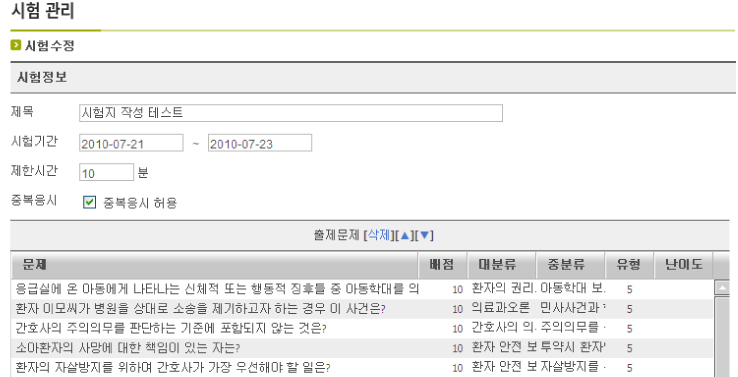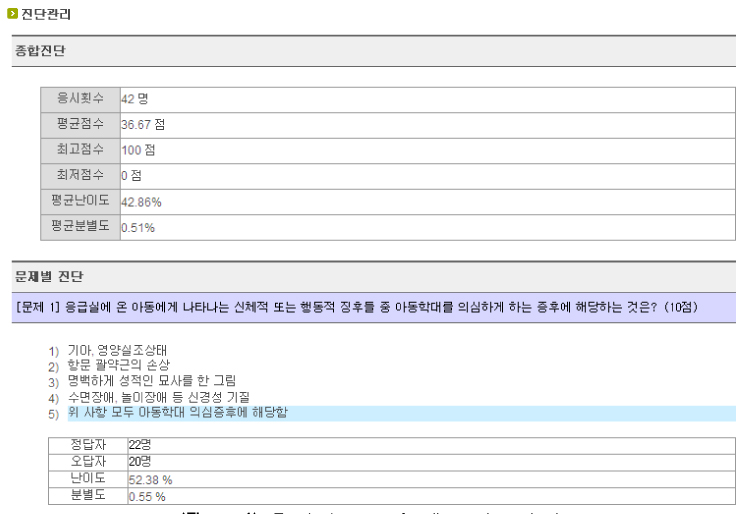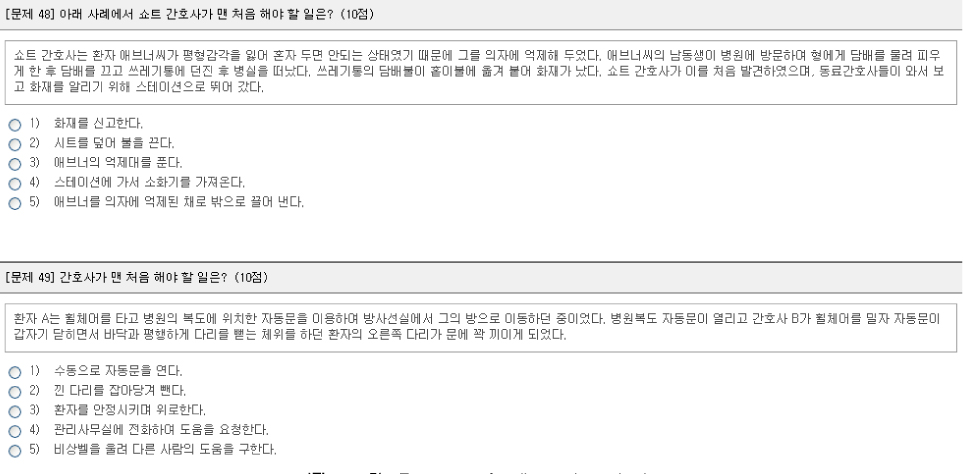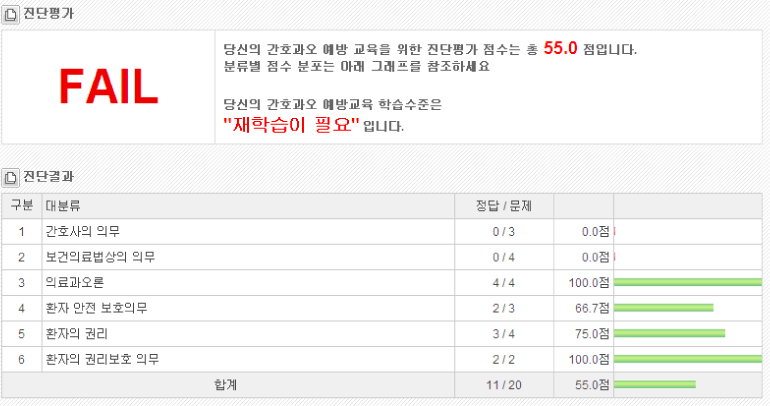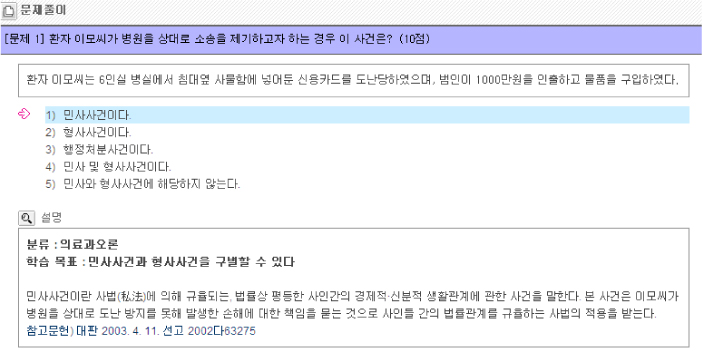J Korean Acad Nurs Adm.
2011 Mar;17(1):33-43.
Development of a Web-based Diagnostic Evaluation Program for Prevention of Nurse Malpractice Liability
- Affiliations
-
- 1Department of Nursing, Wonju College of Medicine, Yonsei University, Korea. kyongkk@yonsei.ac.kr
Abstract
- PURPOSE
This study was done to develop a web-based diagnostic evaluation program for nurses to prevent malpractice liability.
METHODS
A comprehensive review of the literature and 9 specialist interviews were used to search for learning goals and content for protection for nurses from malpractice. Data on needs for learning goals were collected from 56 hospital nurses who agreed to complete a self-report questionnaire. The diagnostic program was evaluated between September 2008 and August 2009 by 35 new hospital nurses using an application of the web-based program evaluation tools by Chung (2000).
RESULTS
A comprehensive review of the literature and interviews were used to search for learning goals and content. The evaluation program was composed of the 73 questions for diagnostic evaluation under 23 learning goals and 6 grand learning goals which included the principles of law, patient's rights, legal responsibility, patient's safety, regulation on nursing practice and patient's rights protection. Evaluation of the program showed that the mean for program evaluation was 3.43 (SD=.37).
CONCLUSION
This diagnostic evaluation program could be an efficient method for teachers and learners to improve nurses' behavior in protecting the patient's rights and preventing malpractice claims.
Keyword
MeSH Terms
Figure
Reference
-
1. Bernzweig EP. The nurse's liability for malpractice: a programed course. 1996. 6th ed. St. Louis, Missouri: Mosby Publication.2. Cheong YS, et al. The Development of a clinical ethics core curriculum for medical trainees in Korea. Korean J Med Ethics Educ. 2008. 11(2):183–190.
Article3. Cherry B, Jacob SR. Contemporary nursing: issues, trends and management. 1999. St. Louis, Missouri: Mosby Publication.4. Choi JS, Kim KS. Application and evaluation of a web-based education program on blood-borne infection control for nurses. J Korean Acad Nurs. 2009. 39(2):298–309.
Article5. Chung HJ. Development and effectiveness of hemodialysis nursing education program using web-based learning system. 2000. Seoul: Yonsei University;Unpublished master's thesis.6. Chun HY, Kang SY, Kim JM. A Study on the learning effects and recognition of web based instruction of pre-early childhood educators. J Future Early Child Educ. 2004. 11(3):119–139.7. Ha TH, Lee BJ. Education using computer: Design and implementation of web-based learning and evaluation system based on IPI model - Focusing on computer study at middle school. J Korean Assoc Comput Educ. 2004. 7(1):107–118.8. Hong JG, Jun WC. An Item Pool System for Leveled Assessment. J Korean Inf Educ. 2002. 6(3):298–307.9. Kim KK, Song MS, Rhee KS, Hur HK. Study on factors affecting nurses' experience of non-reporting incidents. J Korean Acad Nurs Adm. 2006. 12(3):454–463.10. Korean Nurses Association. Korea ethical code of nursing. 2007. Seoul: KNA.11. Korean Nurses Association. The report of development on nursing standards. 2003. Seoul: KNA.12. Marble H, Joann T, Chouh JL. An Exploration of content on legal aspects of practice in nursing programs. J Nurs Educ. 1999. 38(9):400–406.
Article13. McCrary SV, Swanson JW, Perkins HS, Winslade WJ. Treatment decisions for terminally ill patients: physicians' legal defensiveness and knowledge of medical law. Law Med Health Care. 1992. 20(4):364–376.
Article14. McGuire WJ. The yin and yang of progress in social psychology: Seven koan. J Pers Soc Psychol. 1973. 26(3):446–456.
Article15. National Health Personnel Licensing Examination Board. The guideline for development of questions. 2009. Seoul: NHPLEB.16. Park HW, Kim SY, Sohn MS. Legal perspectives on the educational goals of ethics programs formedical trainees. Korean J Med Ethics. 2009. 12(3):235–250.17. Park JH, Kim YS, Kim WO. The Present status and future directions of nursing ethics education. Korean J Med Ethics. 2009. 12(3):251–260.
Article18. Shin KR. The development of educational goals for nurse. Paper presented at the workshop of the Korean Nurses Association on the registered nurses' national examination for professor. 1999. 01. Seoul:19. Young JB. A qualitative study on self-directed learning in cyber space. J Curriculum Stud. 2010. 28(2):205–223.
Article20. Yu BH, Kang SG. Investigation on Web Based Diagnostic - Formative Evaluation System for Mathematics Education. J Korea Soc Math Ed Ser A: The Mathmatical Education. 2003. 42(5):673–682.21. Yu SG, Lee MJ. Computer education curriculum and instruction: Education using computer; design and implementation of a web-based diagnostic evaluation system for efficient teaching method. J Korean Assoc Comput Educ. 2003. 6(3):197–205.22. Williams PC, Winslade W. Educating medical students about law and the legal system. Acad Med. 1995. 70(9):777–786.
Article
- Full Text Links
- Actions
-
Cited
- CITED
-
- Close
- Share
- Similar articles
-
- Analysis of Legal Liability in Medical Accident due to Nursing Practice through Precedents
- The Legal Doctrine on 'Limitation of Liability' in the Precedent Analysis on Plastic Surgery Medical Malpractice Lawsuits
- Development and Evaluation of a Web-based Ostomy Self-care Education Program
- Development and Evaluation of a Web-based Education Program to Prevent Secondary Stroke
- Development and Evaluation of a Web-based Support Program for the Maternal Role of Primiparas



